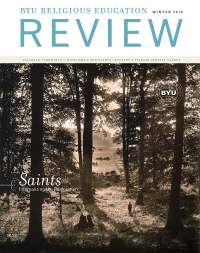My Dear Sister: Letters between Joseph F. Smith and His Sister Martha Ann Smith Harris
Historian's Corner
Joseph F. Smith gathered his family each November to celebrate his birthday. Following his death on 19 November 1918, the family continued the annual tradition, honoring their husband, father, grandfather, and great-grandfather. Today, the Joseph F. Smith Family Association still holds a reunion on the Monday closest to his birthday. The reunion gives family members a chance to learn about their family through talks and presentations on Joseph F. and his five wives: Julina Lambson Smith, Sarah Ellen Richards, Edna Lambson, Alice Ann Kimball, and Mary Taylor Schwartz. The family honors his living grandchildren and all eight-year-old descendants who have been baptized or are about to be baptized. There are an estimated 8,066 descendants, of which 7,513 are living. If spouses are included, the number jumps to 11,268, of which 10,405 are living.
During the most recent reunion held on Monday evening, 12 November 2018, at the Monument Park Stake Center in Salt Lake City, the family received Richard Neitzel Holzapfel’s final report on the brand-new book My Dear Sister: Letters between Joseph F. Smith and His Sister Martha Ann Smith Harris, edited by Dr. Holzapfel and Dr. David M. Whitchurch and copublished by Brigham Young University’s Religious Studies Center and Deseret Book.
The 241 letters included in the published volume are a treasure trove of personal insights into the lives of Joseph F. and Martha Ann during a unique era of Latter-day Saint history. Over six decades of correspondence help demonstrate the tremendous devotion between the orphaned children of Hyrum and Mary Fielding Smith as they share their innermost feelings, joys, heartaches, determinations, and family happenings. Some compelling information found within the letters include reflections on the death of their parents and remarks about the visit of the Prophet Joseph Smith’s sons, David and Alexander (Joseph F.’s first cousins), who traveled from Nauvoo to Salt Lake City.
The letters range from 1854, when Joseph F. was a fifteen-year-old missionary in Hawaii, to 1916, when he was President of The Church of Jesus Christ of Latter-day Saints. This book contains transcripts of all the associated letters and is richly complemented by photographic images of people and events representing the lives of Joseph F. and Martha Ann. A biographical register helps readers sort people and time periods.
At a Smith family reunion many years ago, Dr. Holzapfel introduced the family to the letters, most of which were preserved by Carole Call King, Martha Ann’s great-granddaughter. King did not realize the treasure she inherited when her father, Anson B. Call Jr., passed away. Busy with the funeral and other family demands, she overlooked the contents of one box. Left unnoticed on a closet shelf for some time, it caught her attention one day as she was putting away the vacuum. In the bottom of the box, underneath her mother’s chiffon wedding dress, she found three small, long, narrow boxes neatly wrapped in tissue paper. On them her grandmother Sarah Lovina Harris Passey had written in her own hand the words “Letters to mother.”
King opened a box and discovered inside nearly a hundred original letters written by Joseph F. Smith. Joseph F., for by that name he was affectionately called, had addressed and sent them to his younger sister Martha Ann.
Holzapfel, a professor from Brigham Young University at the time, contacted King after hearing about an 1854 letter that she had found in one of the boxes that included a lock of Joseph F.’s hair in the envelope. In the course of their conversation, Holzapfel learned about the other letters and arranged to visit with her the following day at her home in Mountain Green, Morgan County, Utah. King graciously showed him the collection of handwritten letters, many of which were inside their original envelopes. During their conversation, King gave Holzapfel permission to copy, transcribe, and publish this important collection of personal letters.
In the months that followed, Holzapfel invited Whitchurch to join the project. Whitchurch oversaw the challenging transcription effort, producing summaries of each letter along with a biographical register. At the same time, Holzapfel began searching in several institutional repositories for additional letters, researching material for historical summaries for each decade represented in the letter collection, and gathering information to be used to annotate each letter to help readers contextualize the documents.
Another important development occurred when Carole Call King donated the collection of letters and envelopes to the Church History Library in Salt Lake City. In response to her generosity, the Church provided Holzapfel and Whitchurch copies of Martha Ann’s letters to Joseph F. housed in their collection, which had previously been closed to researchers. Additional letters were donated to the Church History Library by other Harris family members.
Holzapfel and Whitchurch searched the Church History Library and the libraries at BrighamYoung University, the University of Utah, and the Utah State Historical Society looking for additional letters. Eventually, they discovered nineteen of Joseph F.’s letterpress copybooks at the Church History Library, two in private possession, and one at the University of Utah. Copies of sixty-nine letters are preserved only in Joseph F.’s letterpress copybooks, the originals not having survived. Additionally, one incomplete original Joseph F. letter was handed down in the family. Fortunately, a complete copy of that letter is found in one of the copybooks. The letterpress copybooks offer clues to help date letters when questions arise about the exact date of composition. In cases where original letters are damaged by tears or holes, copies from the letterpress copybooks have made it possible to produce more complete and accurate transcriptions.
This is a masterful collection of letters, history, and biography—all rolled into one. The editors have left no stone unturned, scouring archives and personal collections, creating decade introductions, and sharing historical context to breathe life into their stories.
